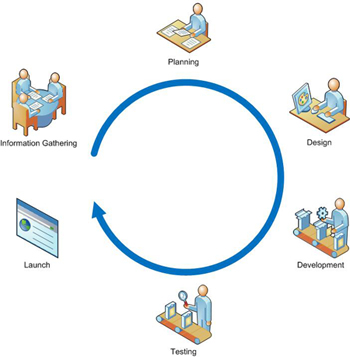Design and Development Process
We work closely with our clients to design and develop projects.
Before beginning a project, we will put together a detailed project schedule outlining specific deliverables & dates of delivery from 4M Web Design to you, as well as time frames for your feedback and approvals for each stage of the project. Each project phase affects the subsequent phases and depends upon the specific deliverables & project milestones through which the project will progress. Client approvals are required for each stage of the project.
The following steps outline 4M Web Designs approach.

Phase I: Information Gathering
During the information gathering stage, we spend time getting to know you and your business or organization. We may ask you to provide copies of your current marketing materials & we will ask you a lot of questions.
We work to understand your Overall Business Strategy, Marketing Objectives, Target Audience & Customers and Competition.
Phase II: Planning
Using the information gathered from phase one, it is time to put together a plan for your website. This is the point where a site map is developed. We also produce a Website Planning Sheet which is a questionnaire designed to enhance communications between 4M Web Design and our clients.
The site map is a list of all main topic areas of the site, as well as sub-topics, if applicable. This serves as a guide as to what content will be on the site, and is essential to developing a consistent, easy to understand navigational system. The end-user of the website – aka your customer – must be kept in mind when designing your site. These are, after all, the people who will be learning about your service or buying your product.
Our goal is to make your site easy to navigate, fast loading, and aesthetically pleasing.
Phase III: Design
Drawing from the information gathered up to this point, it’s time to determine the look and feel of your site. Every choice, from layout and color to type size and style is made with your communication goals in mind. The stand-out ideas are chosen for development into initial concepts, and are further refined. We then present the initial concepts to you and work with you to turn these concepts into comprehensive design directions.
We will create one or more prototype designs for your website. This is typically a .jpg image of what the final design will look like.
During this stage, constant communication is key! We will require feedback & approval on Design Concepts & Mockups, and, if 4M is writing or editing content for the project, a complete list of the pages to be written or edited.
Phase IV: Development
The developmental stage is the point where the website itself is created. At this time, we begin to build your website according to the Design Concept & Mockups previously shown. The Production Phase is often the longest phase of the project process. We build all pages and propagate with content and graphics. This involves writing valid XHTML / CSS code that complies to current web standards, maximizing functionality, as well as accessibility for as large an audience as possible. Elements such as interactive contact forms, flash animations or ecommerce shopping carts are implemented and made functional during this phase, as well.
Phase V: Testing and Delivery
Testing, testing, testing and yes, more testing! Once the project has been built it will be thoroughly tested to ensure it is error-free. We check cross browser compatibility and resolution. We also take the necessary time to do a complete site check. We then turn it over to you to review and test. Revisions, if needed, are made to the project based on testing and feedback.
Also as part of testing, we will check to be sure that all of the code written for your website validates. Valid code means that your site meets the current web development standards – this is helpful when checking for issues such as cross-browser compatibility as mentioned above.
Phase VI: Launch
Once you have approved your new website and any revisions, we will publish your site to the space on your web server. Publishing a website is a lot easier than publishing a book, or even printing a brochure. An FTP (File Transfer Protocol) program is used to upload the website files to your server. Once the files are copied to your web server space, your website is instantly "live" for the entire world to see.
We make a copy of your site and put it onto a CD for backup storage purposes.

